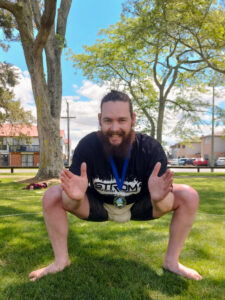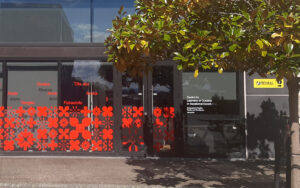Breaking the silence around loss of a baby
Sands NZ charity wants to break the silence and raise awareness of baby loss. Reporter Shontelle Cargill talks to a bereaved mother about her loss and a Waikato remembrance lawn for angel babies.
Not a day goes by that Waikato mother Cathy Buntting doesn’t think of her daughter who was delivered stillborn, nine years ago.
Buntting cradles a soft lilac teddy bear in her arms as she speaks of her first-born child, Megan. It is a possession she treasures, bought in memory of her baby.
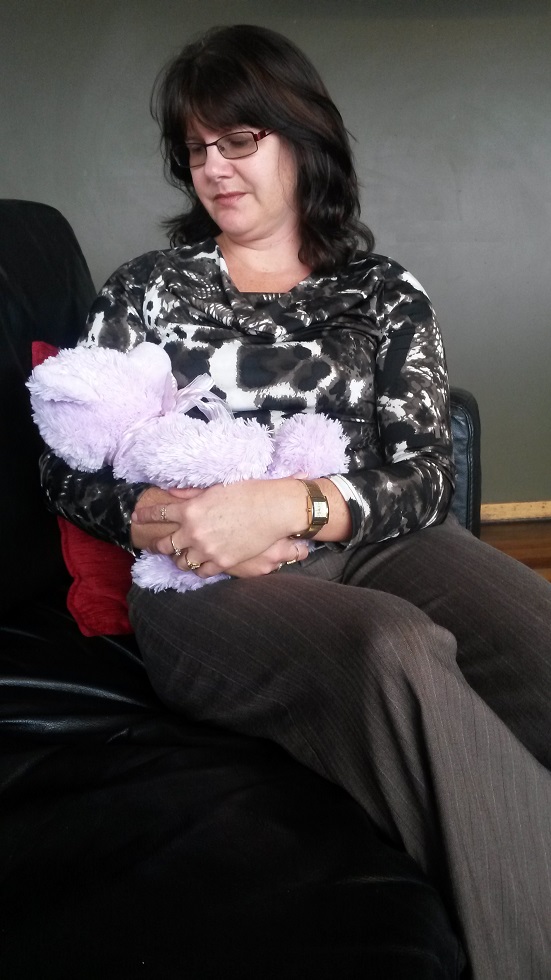
memory of her baby. Photo: Supplied.
During Buntting’s pregnancy, she was diagnosed with pre-eclampsia, which is a disorder characterised by high blood pressure in pregnant woman. She was taken to the newborn intensive care unit in Waikato Hospital where doctors prepared her to have a premature baby.
Doctors had planned for her to deliver at the end of the week. But during a regular scan check-up a few days prior, Buntting and her husband received devastating news.
“They just couldn’t find her heart beat,” Buntting explains.
Megan died at 31 weeks’ gestation. An autopsy report revealed the death was probably caused by blood clots that had formed in a knot in the umbilical cord.
“We walked home without a baby – she was so close to being delivered,” Buntting says.
Doctors could not have predicted the knot in the umbilical cord.
“We now live with the wish that we had a prem-baby, deliver her a few days early,” Buntting says sadly.
The hospital medical staff were immensely supportive and compassionate, she says, although she knows that isn’t always the case for all other bereaved parents’ experiences.
Bunting is the co-convenor for the Waikato region of Sands NZ, a voluntary, parent-run, non-profit organisation. Sands NZ support bereaved parents and families who have experienced the death of a baby at any stage during pregnancy, as a baby or infant.
“She was deeply wanted, loved, anticipated, expected – and then we went home without her.” – Cathy Buntting
Often when that happens, loss and grief is seen as the ‘uninvited guest’ – people feel uncomfortable to speak about or even acknowledge it. One of Sands NZ’s goals is to break the silence.
A regret Buntting has is that she delivered Megan naturally which meant she was in the delivery suite for two days waiting for her to be born, while hearing other mothers in labour and newborns crying. All the while knowing her baby’s fate.
“She was deeply wanted, loved, anticipated, expected – and then we went home without her.”
After such heartbreak, you have to recreate dreams, Buntting says.
This is something she still struggles with, to plan too far ahead, as she doesn’t have the trust that everything will go as planned. She doesn’t want to have to rewrite her future like she once had too.
After Megan’s death, Buntting had a funeral for her daughter at Hamilton Park Cemetery in Newstead.
“I remember that day so clearly – my legs feel physically heavy, remembering the absolute agony of walking to the car to drive to her funeral. Like walking the plank. Of everything that happened, that was one of the most difficult moments,” Buntting says.
During that time the funeral director told them of the Kowhai Lawn, a remembrance area for bereaved parents.
Kowhai trees surround the brick pathway that leads to the centre of the remembrance area.
Along the pathway are several tiles cemented into the walkway with pictures of teddy bears and a piece of the ‘teddy bears picnic’ poem written on each one.
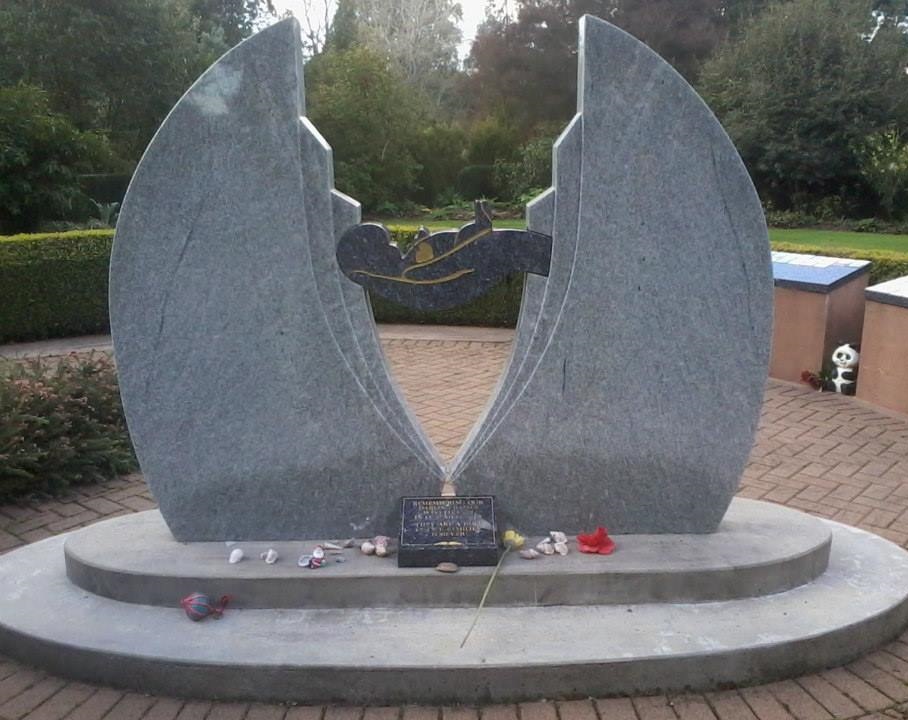
At the end of the pathway stands a large granite sculpture of a parent’s hand holding a baby with a gold heart over the baby’s chest.
An inscription on the sculpture reads: ‘Remembering our darling babies who live on in our memories. They are a part of our families forever.’
Two pedestals stand next to this, where porcelain memorial plaques can be placed on top. Cathy Buntting’s daughter Megan’s plaque is one of many currently there.
David Tomlinson at Creative Stone has made many of the plaques at the Kowhai Lawn for bereaved parents.
In 2012, Tomlinson wanted to do something for the community in appreciation of the work his business was getting across general memorial work.
He decided that Creative Stone would offer to make and install the 6x8cm porcelain plaques for the Kowhai Lawn free of charge. That way bereaved parents only had to pay the permit fee to the council to install the plaque.
“We also lobbied hard to have the council reduce the $95 permit fee for the plaque, which was dropped to $40 after a period of time,” Tomlinson says.
Tomlinson and one other staff member start by making an “image” of the plaque on a computer. This includes words and graphics as required. Then a machine creates an image for the plaque using metal oxides. Unlike a normal printing machine, metal oxides will not fade in UV light.
Tomlinson says there are a few challenges with this process, as the colour range is limited, but it is very good for all skin tones when they do pictures of people. The image is then fired on to a specially imported porcelain tile, designed for memorial photo work.
“Thankfully they do not seem to be needed too often, probably about one inquiry every three months or so,” Tomlinson says.
According to Sands NZ, every year in New Zealand more than 700 babies die between 20 weeks gestation and 12 months of age. A further 10,000 babies die as a result of an early pregnancy loss before 20 weeks’ gestation.
“What we know from the thousands of parents we have talked too is that compassion can make all the difference. Compassion isn’t about technology or strategies, it’s about being human and empathetic.” – Vicki Culling.
Former Sands NZ chairperson Vicki Culling runs her own business, Vicki Culling Associates, which provides training workshops to help healthcare professionals support newly bereaved parents during their times of loss.
Culling knows of this loss all too well, after her daughter died in 1998. Her involvement with Sands NZ began two years later.
Some healthcare professionals are fearful of doing or saying something wrong when working with and supporting bereaved families and that can then impact on the care provided.
“What we know from the thousands of parents we have talked too is that compassion can make all the difference. Compassion isn’t about technology or strategies, it’s about being human and empathetic,” Culling says.
She says in her experience health professionals find this aspect of maternity care to be one of the most challenging. Training, education and sharing of information is crucial, she says.
“No health professional sets out to make anyone’s experience substandard or traumatic. But sometimes, as with any area, we don’t know what we don’t know. And if we’ve been doing something a certain way then that’s the way we’ll continue to do it.”
Culling and Buntting agree there needs to be more awareness of baby loss in order to help support bereaved parents and so they know what support is out there for them.
This is where organisations such as Sands NZ comes in. Every year they hold a “baby loss awareness week” in October. Sands NZ hold free memorial events throughout the country during this week, to help support bereaved parents and raise more awareness so baby loss is not seen as such a taboo subject.
Every two years they hold a Sands NZ conference for bereaved parents and healthcare professionals.
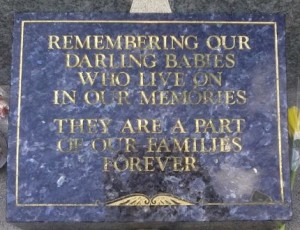
Culling helped organise this year’s conference, which was held in Wellington June 19-21, and took 21 months of hard work to plan.
“Sands conferences have always been unique in that we bring together professionals and parents and we learn from and with each other,” Culling says.
Buntting says having a plaque for Meagan at Hamilton Park Cemetery’s remembrance area gives her a place to go and connect with her.
“I think of her every day, in all sorts of places. The Kowhai Lawn has become somewhere very special to me,” Buntting says.
“Often I cry – for Megan, and also for all the other families who have precious babies there.”
She also often walks through the apple blossom lawn where babies and children are buried too. Buntting describes it as overwhelming at times, to think of the huge number of families facing life knowing that part of them is missing.
Now, nine years later, when she visits the Kowhai Lawn it gives her a sense of peace. She says the plaque gives the world a physical reminder that Megan lived.
Buntting says she has come to realise that with courage and hard work, it’s possible to once again live a life that feels meaningful.


